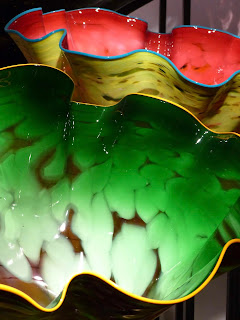 The glass sculptor is famed for learning the time-honoured techniques of Venetian glass blowing, then adapting them into fantastical works of modern art. He's known for enormous chandeliers of writhing tentacles, collapsing bowls that look like sea urchins, undulating platters that become enormous flowers and spears of bold colour. He often displays his pieces in large groups, compounding the explosive blast of colour. He's also very fond of teaming with botanical gardens, where his work can be placed amongst living things to show off its organic nature.
The glass sculptor is famed for learning the time-honoured techniques of Venetian glass blowing, then adapting them into fantastical works of modern art. He's known for enormous chandeliers of writhing tentacles, collapsing bowls that look like sea urchins, undulating platters that become enormous flowers and spears of bold colour. He often displays his pieces in large groups, compounding the explosive blast of colour. He's also very fond of teaming with botanical gardens, where his work can be placed amongst living things to show off its organic nature.London's Royal Botanic Gardens at Kew are now six months into a seven-month show called Chihuly: Reflections on Nature, which is packing in the visitors. There's a trail of 32 artworks in 13 locations, including gardens, glasshouses and an indoor gallery for smaller, more delicate works. Kew is a big place and the installations are widely-spread, so seeing it all will take at least half a day. If your time is more limited, head directly to the Temperate House, where you can see the densest concentration of installations outside of the gallery and appreciate the newly-cleaned and restored glass and steel structure of a Victorian architectural treasure.
I suspect critics of "serious" modern art turn their noses up at Chihuly and probably tar him with a contemptuous "populist" brush. He also comes in for criticism as being a producer rather than an actual artist. Physical disabilities have prevented him from blowing glass himself since very early in his career: he designs and a large workshop implements. Many of those he's trained have gone on to do very similar stuff, and his influence has cascaded down into tableware and decorative pieces in high street home stores. I don't much care. Chihuly has always given me great joy, and continued to do so across Kew.
I've been fortunate to get up close and personal with his work thanks to my art historian mother. His major exhibition at the Saint Louis Art Museum took place right after she started working there, so I got all sorts of behind-the-scenes access and plenty of education. In the next decade he was back in town at the Missouri Botanical Gardens, doing an early version of what we see today at Kew. Some of the forms, like the magnificent blue and white starburst exploding outside a Doric temple, are new since my St. Louis encounters.
But most of what's at Kew will be familiar to anyone who's seen a Chihuly exhibition before. Which did get me thinking. Chihuly's glory days were solidly in the '80s, with a bit of active work in the years on either side of the decade. Since then, his blockbuster exhibitions around the world have increased as his fresh ideas have dwindled. His workshop produces in enough bulk to fuel four current major exhibitions. That's on top of eight permanent exhibitions and individual pieces in museums, gardens and other public spaces across the globe. Is this modern art, or a design brand? It's certainly no surprise that Chihuly's permanent home in London is in the design-focused Victoria and Albert Museum, where one of his chandeliers hangs in the main rotunda, rather than in Tate Modern.
The Kew show, however, reinforces my opinion that his essentially organic forms look best in nature, where their striking colours either contrast with the green background:
or blend in so thoroughly it's hard to tell where nature ends and Chihuly begins.
My favourites remain his Seaforms series, where pieces look like they've just been plucked from a coral reef.
And I think few people do "blue" as well.
But the most striking image in the whole Kew show is probably inside the water lily house, where white flowers arc out of a carpet of pads and blooms, extending their impact through the reflections below.
Chihuly: Reflections on Nature is on until 27 October and included with the gardens' admission price. You can also see Chihuly Nights from 7:30 to 10:30, when the works take on a totally different appearance as they're illuminated against the darkness. Sounds like a great way to cope with the shrinking daylight, but book in advance. The night sessions are only on Thursdays, Fridays and Saturdays and are likely to sell out as the show gets close to its end.










No comments:
Post a Comment